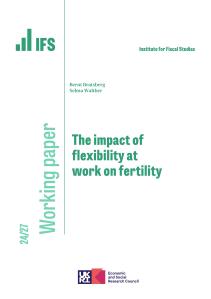In the run-up to Chancellor Hunt’s first Budget there has been media speculation about possible reforms to help parents with the cost of childcare, amid a wider review ongoing within government of workforce participation. Here we bring together a very brief summary of the key evidence on this issue. We draw significantly on a recent IFS submission to the Education Select Committee’s inquiry into childcare and the early years, as well as a number of other pieces of work.
1. The policy landscape
Early years support in England is complex and hard to navigate
Support for childcare in England is complicated, with at least eight different programmes to help families with the cost of care, and with many families eligible for more than one form of support simultaneously. This complexity makes it difficult for parents to work out what support they’re entitled to and how to get it. Having multiple programmes for different (but overlapping) groups, operating in different ways, also makes it harder for policymakers to introduce coherent reforms.
Funding for the free entitlement is falling
One pillar of the early years landscape in England is the ‘free entitlement’ to funded early education and childcare. All 3- and 4-year-olds are entitled to 15 funded hours per week during term-time, while those in working families1 can get up to 30 hours a week. The 40% most disadvantaged 2-year-olds are also entitled to a funded part-time place.
Since 2009-10, spending on the free entitlement has more than doubled as the government increased the number of funded universal hours and brought in new entitlements for 2-year-olds and for 3- and 4-year-olds in working families. This has created a large shift in the landscape of early years support, prioritising slightly older children while spending on programmes available to younger children has fallen.
While each of the last three Spending Reviews increased the budget for core funding per hour to deliver the free entitlement, inflation – and particularly a rising minimum wage – mean that these increases have lagged behind the rise in providers’ costs. Since its peak in 2017-18, the core hourly funding rate for 3- and 4-year-olds has fallen by 14% in real terms when provider-specific cost pressures are taken into account. We’re set for a further fall of about 3% over the next two years.
Low funding for the free entitlement hours can have consequences for parents of entitled children, who might be asked for “voluntary” contributions to secure their place (though these are regulated). Providers looking to cut costs in response to a funding squeeze might also end up reducing the quality of care on offer. But a tighter funding landscape for the free entitlement hours also has consequences for parents of younger children, as some providers respond to a squeeze on free entitlement funding rates by raising prices on parent-funded hours.
Tax-free childcare
While nearly all parents are aware of the ‘free entitlement’ to a funded place for 3- and 4-year-olds, IFS research found that in 2019 just four in ten parents with pre-school children had even heard of Tax-free Childcare – which essentially offers a 25% subsidy (up to a cap) to childcare costs for almost all working families This has contributed to persistent under-spending in the tax-free childcare budget: in the first three years of the programme, the government spent £1.7 billion less than it had planned.
There are some encouraging signs that awareness and take-up might have risen in recent years, with new government information campaigns and an upward trend in tax-free childcare spending. However, total spending on ‘tax reliefs’ for childcare (including both tax-free childcare and the employer vouchers it replaces) fell by around a third during the pandemic as demand for childcare fell. It is not yet clear how much demand, and hence spending, will recover this year.
Means-tested childcare subsidies within benefits
Families on Universal Credit where all parents are in paid work can get 85% of their childcare expenses reimbursed, up to a limit of £760 per month of eligible expenses for families with one child and £1,300 for those with two or more. (Families that are still on legacy benefits get a smaller subsidy of 70% of childcare expenses, but are subject to the same caps.)
In 2009-10, spending on these subsidies roughly equalled free entitlement spending. A decade later, IFS analysis found that free entitlement spending was four times as high as spending through the benefits system.
In part, this reflects deliberate policies prioritising the expansion of the free entitlement, especially with the introduction of the 2-year-old offer and the 30-hour entitlement. Partly, it reflects low take-up: statistics released by the Department for Work and Pensions (DWP) suggest that just 25% of families on Universal Credit with a pre-school aged child and where all parents are working are accessing any childcare subsidies. Among all eligible families, the take-up rate is 13%. And it partly reflects policy decisions within the benefits system, such as cutting the subsidy rate from 80% to 70% for families on legacy benefits; freezing the caps on eligible expenses in cash terms; and moving to a system under Universal Credit where families receive subsidies only once they have paid for care out-of-pocket.
Payment in arrears
A different approach would be to change how childcare costs are supported through Universal Credit. Currently, claimants must pay childcare costs up front and then once a month get them reimbursed by DWP. This is consistent with the overall approach of Universal Credit, which is paid in arrears rather than in advance – but it may create a barrier for families who want to work but lack the disposable cash to pay for a month’s childcare costs out of pocket.
To give a sense of scale, out-of-work families on UC with a 1- or 2-year-old child have an average monthly income of £1,750. In-work families on UC with a 1- or 2-year-old, who use paid childcare, have an average gross monthly childcare expenditure of £585. If these out-of-work families moved into work and used childcare, these figures suggest that their available income between paying the up-front childcare costs and receiving their first paycheque might be about a third lower than if they remained out of work.
Reports suggest that the Treasury is considering paying the childcare element in advance instead. Such a plan might help ease the transition to work for some workless households, and help with budgeting for those already receiving the childcare element.
While attractive in principle, such a policy also risks over-payments for childcare expenses. For example, suppose that a family reports next month’s childcare costs to DWP and receives the childcare element. Then, in that next month they happen to work more hours such that they are not entitled to Universal Credit at all, and so the childcare element has been overpaid. DWP would then either have to write off the overpayments, meaning additional cost to the taxpayer and increased risk of fraud, or try to recoup it. The process of debt recovery is not always straightforward for either the claimant or DWP.
Frozen caps
The caps on eligible childcare expenses in the benefit system have been frozen in cash terms since 2005–06, leading to a real-terms cut in their generosity of 56%. Had the caps increased in line with inflation, they would now be close to £1,200 and £2,000 respectively (rather than the actual levels of £760 and £1,300 respectively).
While it is good policymaking practice to ensure that – whatever their level – caps by default maintain their real value over time, even a sizable increase to them now would be unlikely to have much of an impact on many families. The average claimant of the childcare element in Universal Credit receives £329 per month – only about half of the maximum amount for one child. Precisely how many families are affected by the caps is difficult to determine with available data, but our estimates put it in the tens of thousands.2
The maximum support in Tax Free Childcare has also been capped at £2,000 since the scheme was introduced in 2018, implying a 16% real terms fall – though again for many these caps do not bind, with the average top-up at £800 in 2021–22.
2. How is childcare used in England?
Free hours shape parents’ choices – but many families leave hours on the table
Overall, about a third of 1-year-olds, 60% of 2-year-olds, and close to 90% of 3- and 4-year-olds use some formal childcare. The government’s offer of free hours has a powerful effect on how much childcare families use; nearly 30% of families whose 3- or 4-year-old is eligible for 15 free hours use exactly that much childcare. Another 40% of families eligible for (only) the universal entitlement use more than 15 hours a week, paying for some formal childcare out of pocket.
Perhaps surprisingly, among those entitled to 30 hours a week of childcare, nearly 60% of families use less than their full entitlement. This does not mean that there is no role for policy: if this pattern reflects constraints, like difficulty in finding a provider willing to deliver the full 30 hours, there might still be a case for intervention to support these families. But it does suggest that, for this (narrow) majority of families, insufficient hours entitlement per se is not something that they struggle with, and that an expansion of those entitlements would not immediately benefit their budgets.
Childcare affordability depends on the child’s age
The patchwork nature of England’s early years system means that, while some families receive considerable government support, others bear the brunt of childcare costs on their own. Challenges with expensive childcare are particularly acute among 1- and 2-year-olds: compared to families with older children, these families face a ‘double whammy’ of higher prices and substantially less government support. More than half of families using formal childcare for their one-year-old paid more than £90 a week for care. By age 3, the median family using formal childcare pays less than £5 a week.
Most families are not struggling with their current childcare costs…
Perhaps surprisingly, evidence suggests that the majority of families – even with very young children – do not say they are struggling with their childcare costs. In 2019 (the last year of data available), around a quarter of families using formal childcare for their 1- or 2-year-old found it ‘difficult’ or ‘very difficult’ to afford their childcare costs. Of course, rising costs in the last few years might have added to the pressure on families.
… but for a significant minority, childcare costs are a significant burden
Average figures for spending or difficulty affording childcare obscure an awful lot of variation in how different families experience childcare costs. 15% of families with a one-year-old in formal childcare spent more than £200 a week on childcare in 2019 – equivalent to more than £10,000 a year. Even more modest costs can be particularly difficult for lower-income families to bear.
High prices of childcare put off some families – but preferences matter too
The cost that families pay now tells us about how important childcare is in families’ current cost of living. It does not say anything about whether the prices of childcare are putting families off from using more, and potentially from working more hours.
Here the evidence is more mixed; just over half of families with pre-schoolers thought local childcare was ‘very’ or ‘fairly’ affordable in 2019, but this varied a lot across different ages of children, levels of family income, and regions of England.
Among families that don’t use childcare at all, preferences seem to be more important than constraints: in 2019, around a fifth of these families cited affordability as one reason for not using childcare. Nearly three-quarters of these parents cited their preference to look after children themselves.
On the other hand, these questions were only asked of the 10% or so of families who did not use any childcare at all over the last year; we know less about the factors shaping the decisions of families who use some childcare but might wish to use more.
3. What does early years spending achieve?
Evidence suggests England’s early years system underwhelms
There is a large international evidence base exploring the impact that early education and childcare provision has on children’s development and on parents’ (particularly mothers’) work decisions and career patterns. The overarching lesson from international studies is that early years education and care can be very successful indeed. In a range of countries, research finds that ‘high-quality’ early education has raised attainment and reduced inequalities. Equally, there is evidence that flexible and affordable childcare can help parents to work, reducing the gender wage gap.
But the international evidence is also clear that subsidies for early childhood education and care often fall short of at least one of these goals. For example, while the Norwegian system of subsidised childcare improved children’s educational attainment, it had virtually no impact on mothers’ working decisions. By contrast, a $7 a day cap on childcare fees in Quebec, Canada helped many mothers to (re)join the workforce, but had little benefit for children’s outcomes (and may have slightly hampered some children’s emotional and behavioural development, with long-run impacts on crime, health and life satisfaction).
In England, research suggests that the 15-hour free entitlement has delivered fairly underwhelming results on both fronts. Research evaluating the 15-hour universal entitlement found no impact on parents’ working decisions. Entering school (and so receiving full-time care) did significantly increase the labour force participation of mothers whose youngest child was affected.
Another evaluation found that the universal entitlement had small benefits for attainment at age five, but these disappeared as children progressed through the school system.
In all of these studies, there is an important distinction between the impact of using childcare and the impact of subsidising it through the free entitlement. Both of the English studies evaluating the free entitlement found that many families were already using (and paying for) childcare even before the entitlements were brought in. For these families, this means that the free entitlement functioned as a transfer (saving them money they would otherwise have spent on childcare fees), but did not necessarily substantially change their childcare decisions – and so it may not be surprising to find that the entitlement itself did not have major effects on parents’ or children’s outcomes.
4. What does this mean for the Budget?
At the moment, navigating childcare in England is complicated and costly for families. The growth in the number of funded hours has been popular with parents, but it has also put pressure on providers and contributed to a shift away from support targeted at low-income working families. As it stands, the system offers relatively little support to families with the youngest children, and it is not clear that the free entitlements are having a large impact either in supporting child development or helping parents to work.
Any significant policy reform in this area will need to be developed carefully, with a view to rationalising the current complicated system, recognising the different goals of early years policies (and sometimes the tensions between them), and responding to the considerable differences in families’ experiences of the childcare system. This will take time: a well-planned set of reforms with a clear set of objectives will need buy-in from parents, childcare providers, employers, and a range of government departments.
But there are a number of smaller improvements that Mr Hunt could make to help the early years system work a little better for families. Given its importance in the early years landscape, ensuring that free entitlement funding remains at a viable level for providers is vital. With childcare providers’ costs rising much more quickly than economy-wide inflation, and tight spending settlements across all public services, this is easier said than done.
Mr Hunt might also choose to look to wider programmes supporting families with the cost of childcare. Raising the profile of tax-free childcare and encouraging families to take up the support on offer to them through the benefits system would both increase the amount of help that families receive.
If Mr Hunt instead looks to reforms to the childcare element of Universal Credit, he should be aware that the caps on childcare expenses are not currently especially binding (even after an 18-year freeze) – though it is certainly good policy-making practice to avoid freezing things in nominal terms for long periods, and they will continue to bind more over time if nothing is done. Reforms to the timing of childcare payments, so they are no longer paid in arrears, might ease the transition into work for families. The challenge of that approach is how to limit or manage the risks of over-payments and potential fraud.
Ultimately, if next week’s Budget provides an opportunity to start a process of reflecting on what we want our childcare system to achieve – and whether it is meeting those goals – then it will have accomplished something very significant in the longer run.












